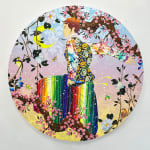-
Tomokazu Matsuyama Japan, b. 1976
Duvel Nostalgia, 2023Acrylic and mixed media on canvas54 x 54 x 2 in.
137.2 x 137.2 x 5.1 cm8902Further images
This tondo by Tomokazu Matsuyama depicts a figure seemingly in motion, striding through a forest or garden. A golden, crescent moon hangs in the baroque, wallpapered sky. Snow is falling...This tondo by Tomokazu Matsuyama depicts a figure seemingly in motion, striding through a forest or garden. A golden, crescent moon hangs in the baroque, wallpapered sky. Snow is falling on an impossible menagerie of birds, butterflies and flowers from different climates and places. The figure is dressed in garments evocative of different time periods. The garments bear design elements referencing art movements from throughout history, from Edo period painted screens to various positions within Modernist Abstraction. A first-generation Japanese American who lives and works in New York City, Matsuyama blends Eastern and Western visual references as a way to address “the struggle of reckoning the familiar local with the familiar global.” As a bi-cultural visual artist, he is keenly aware of the nomadic diaspora, a community of wandering people who seek to understand their place in a world full of contrasting visual and cultural dialects. He is bringing together iconographies that welcome as many people as possible into his work. Rather than conveying a specific message or meaning, his works create spaces of introspection in which individual viewers are able to construct their own narrative, and find themselves in the work. In this image, we see frozen movements evoking the garments of centuries-old Buddhist sculptures; compositional strategies of the European Renaissance masters; iconographic symbols such as the crescent moon, which suggests timelessness, and the yellow cord that may reference a number of cultural icons—from a tasuki used to tie a kimono, to the yellow graduation rope used in academia. Matsuyama hopes that by amalgamating a variety of visual resources into his paintings, all types of viewers will be able to locate themselves in the image. He frequently takes his figures out of the pages of fashion magazines, preferring models who project an androgynous countenance blending femininity and masculinity. The tondo shape is also a significant platform within Matsuyama’s painting practice. He began developing his tondo series around the time when he first transitioned from the field of large-scale public art into regularly exhibiting in museum galleries. The requirements imposed by the so-called “white cube” seemed to Matsuyama to be arbitrary and restrictive, and perhaps intended to force every artist to show their work in the same way. One apparent rule was that paintings should adhere to existing traditions in terms of their shape; a rule that Matsuyama intentionally subverts with every one of his shaped canvases, each being unique to its own composition. “The shape of a tondo allows me to play around,” Matsuyama says, recalling times when he hung circular canvases of various sizes high up on walls, above doors, or in other unexpected places in order to confound the expectations of viewers. The tradition of the circular painting, or tondo, relates to Western art history, and was especially popular amongst Renaissance painters in the 15th century. To Matsuyama, the form also relates to the Japanese tea ceremony. Japanese tea platters can be circular, or they can be shaped. They are not intended to be exactly the same. The Japanese tea house is also designed so you have to crouch to enter. The experience is intended to separate the participant from the rest of everyday life. Matsuyama’s tondos tend to center the figure in a way that evokes the work of Renaissance painters, which is another way that this body of work contributes to his overall conceptual framework of blending intercultural references. “The convenience of our time has made how layered our culture is indefinite,” Matsuyama says. “When we see an image, we try to find connections. I accumulate all of this visual dialect and bring it together as though it has meaning, and the viewers make up a story based on their upbringing.”







